|
|
|
|
Srinivasa Rao Sureddi
Roll Number : 9720313
Dept Of Civil Engineering
Transportation Systems Engineering
Indian Institute of Technology - Kanpur : Aug'1998
Contents
Motivation
THIS INCLUDES THE FOLLOWING :
This work is an important aspect
of finite element analysis and this is called as finite element " mesh
" generation.In this i am trying to devolope a valid mesh using " Quad
Tree Decomposition " and this work is conformed to 2D objects of any geometry
.Finite elenment analysis is perhaps the most popular numerical technique
for solving engineering problem like structural analysis,Fluid mechanics,Mechanical
engineering problems. Finite element meshing is defined as decomposition
of geometry into simple Glued elements such as triangles,quadrilaterals
etc,with no overlap betwwen elements and union of elements cover entire
geometry. In this work i have been using quadrilateral elements(Squares).
Suppose take an example of a Semi
Circle :

It has to be descritised using some mehing techniques to get valid finite element mesh.Using Quad Tree Decompositon this can be descritised as like this as per defined level of tree.
After decompostion it looks as

FINITE ELEMENT MDELLING :
A typical finite element model is
comprised of nodes,degrees of freedom, boundary analysis,elememts.material
properties,externally applied loads, and analysis type.Total process can
be showed broadly as follows.
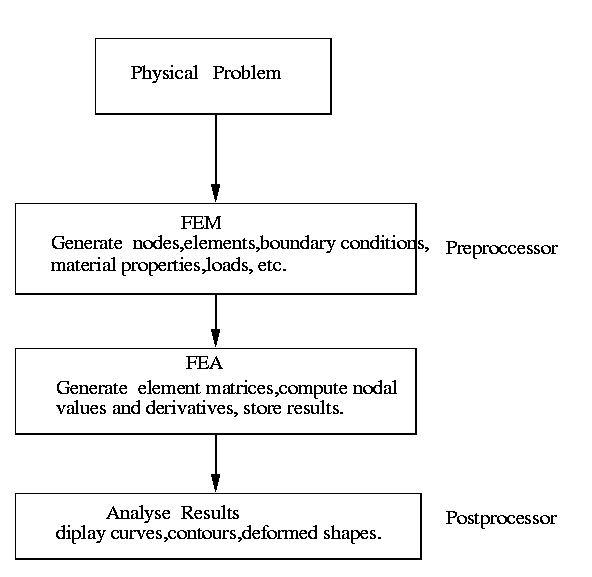
In practice,first must decide on the mesh layout,that is numbner of nodes and elements.Zones of expected abrupt changes in the field variable(such as stress concentration around holes)requirea denser number of nodes and elements than zones where gradual changes occur.This is known as medh gradation.
Another important aspects is section of shape of element,aspect ratio and number of nodes per elements. Triangular or quadrilateral elements are used in most of the times. triangular elements provide good aspect ratio and it results increased number of nodes causing computaionally expencive. On The other hand Quadrilateral elements provide sufficient flexibility and it results decreased number of nodes, But it is difficult generate mesh using quadrilateral elements foe a comlex objects.The following are general shapes which are used.Square elements are used in the Quad Tree decompositon(Varying size).The number of nodes per elements depends on nodal variables(degrees of freedom) and the continuity requirements between elements.
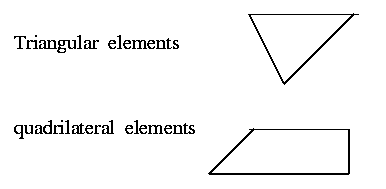
MESH GENERATION :
Mesh generation forms backbone of the FEA.Mesh generation refers to the generation of nodal coordinates and elements.It also includes the automatic numbering of nodes and elements based on minimal amount of user-suplied data. Automatic mesh generation reduces errors and saves a great deal of user time and reducing the FEA cost. Before existing of preprocessors,Finite element meshes were generated manualy. Manual meshing is inefficient,error-prone,and meshing data can grow rapidly and become confusing for complex objcts-especially three dimentional objects.Mainly Mesh generation is complex for comlicated solid objects and Mesh generation is very important and primary step of Finite Element Analysis.With the Widespread use of computer graphics and CAD technology,Mesh generation has been a target for automation.
Mesh Requirements :
-------------
1. Nodal Locations.Nodes must be
lie inside or on the boundaries of the geometric model to be meshed.
2. Element type and shape.It could
be decided depends on compatability and completeness requirements.
3. Mesh gradation.It refers to
the density control of nodes and elements at various locations.
4. Mesh conversion.It may be desirable
to convert a mesh of a given type of element to another mesh of different
element type.Example any quadri laterl eement can be converted into triagular
element.
5. Element aspect ratio.For geometric
invariance,it is important to keep the aspect ratio of any emlement close
to 1,all sides of element are equal in length.
6. Mesh geometry and topology.Mesh
geometry refers to the coordinates of nodal points and the connectivity
information of elements.Mesh topology refers to orientaion w.r.t to actual
object.
7. Cost effectiveness.The it takes
to generate the mesh and the time it takes to perform the FEA are crucial.
Various Methods :
-----------
1. Semi-Automatic Methods:
a.Wireframe or Surface based methods(Delaunay
Triangulation).
b.Solid-Modelling-based Methods.
2. Fully-Automatic Methods.
a.Quadtree Method(For 2D objects).
b.Octree Method(For 3D objects).
Most of people worked to devolpe
triangular element mesh and hardly any work done on quadrilateral mesh
generation.Triangular element has always been the easiest to formulate
and understand for FEA.The triangular were available before the isoparametric
formulation was discovered,which is centered around quadrilateral elements.And
triangular elements provide good aspect ratio and it matches with boundary
approaxmately than other elements.But it results more number of nodes and
more elements in practical situations and it computaionally expensive.So,this
motivated me to devolope quadrilateral mesh which overcome some of those
limitations of triangular elements reasonably.
Quad Tree decomposition of 2d
object devolopes a valid mesh for FEA.Using this Quad Tree decomposition
we can model any complex 2d objects Ex:contour of cost of an ocean,ameaba
etc. The Quad Tree representation has several advantages.
1. Any orbitary shaped objects,
convex or concave with interior holes in case of solids ( Octree representation
is used for 3D objects ) can be represented to the precision of smallest
cell.
2. Geometrical properties such
as surface area,volume,center of mass,and interference are easily calculated
at different levels of precision.
3. Because of spacial sorting and
the uniformity of representation operations on Quad trees,Octrees are efficient.
4. Quadrilateral elements offer
greater flexibility than triangular elements.
5. This Qudtree gives varying density
of elements.It generates very less elemen ts and at edges to generates
highly denser elemets.
6. It provides good aspect raio,Because
all sides of any element are equal.
7. It generates optimum number
of elements and i reduces computational cost drastically.
The building of curve of an object is represented by the set of straight lines and is therefore an approxmation of the original curve by a straight lines which are parallel to sides of original universe space.For objects with complex details, quad tree requires a large number of cells to represent the object accurately. And only approximate properties of the object canbe calculated such as, curvature is lost in these representation.
Another major limitation of the Quad Tree or Octree data structure is the difficulty of incorporating it into existing graphics software systems.
Domain of work
1. This algorithm works any
for complex 2D objects even with holes inside.
2. This works for polygons only
and primarly any object is approximated as a closed polygon.It doesn't
work for curved objects.
3. Union of all squares plotted
doesn't represent actual abject practically (genarally slight more than
actaul object).
4. It shouldn't match exactly with
actual Boundary of an object and it can not retains curvarture property.
Methodology
Decompose a given Object into cells.If these cells are processed properly,they can epresent finite elements. The object of interested is placed inside a square with an integer coordinate system attatched to it at one of its corners.The length of the side of this square in the integer space is pow(2.n) where 'n' is tree level.To decompose object,the universe square is divided into four squares or quadrants.Each quadrant is checked against the object to see if it is inside the object(full),outside the object(empty),or if part of it inside and part of it out side (partial). Homogeneous quadrants (full or empty)require no further subdivisions while partial quadrants is further divided into four quadrants. This process continues until all the quadrants have the status of "full",or practically, until a specified resolution level(Tree Level) is reached.
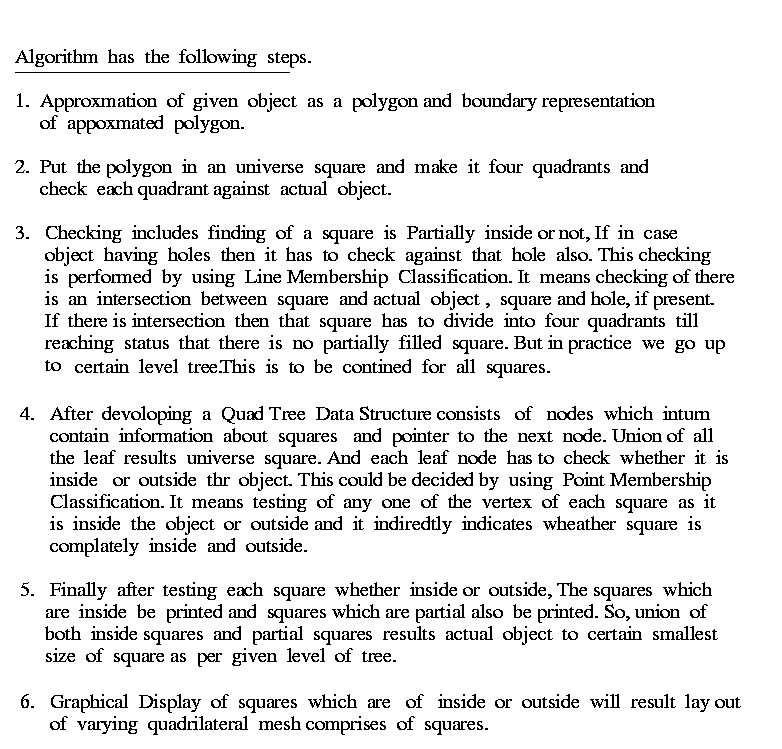
Quad Tree data structure canbe represented as below
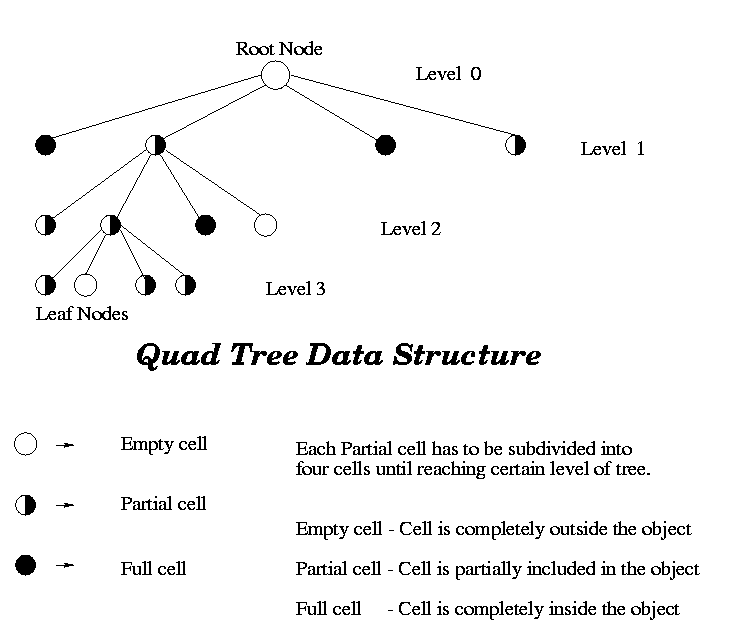
EXPLANATION OF EACH ALGORITHM STEP
FOR THE EXAMPLE OF SEMI CIRCLE :
STEP 1 :
-----
Approxmation of given object into
plygon. The semi circle is approximated with small lines as follows.


After 4th step the decomposed picture
looks as :
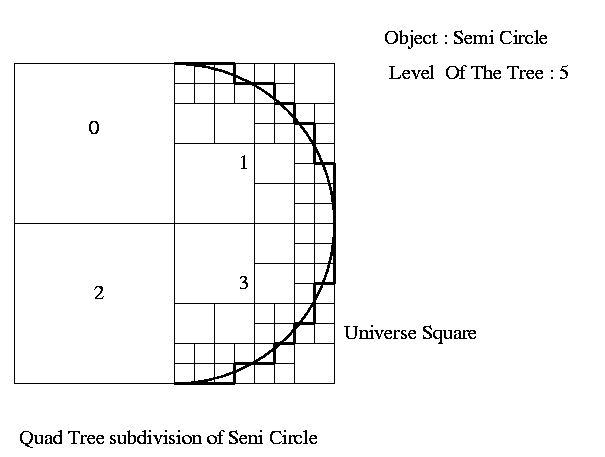
After 5th step finally it looks as :

Explanation of the program :
I have used a recursively calling
tree algorithm to devolope a data structrure. It means Root ( Universe
square ) have four chailds and level of the increased by 1, First node
is tested first if it is partially filled (means it has the intersection
with actual object), Then it will be subdivided into four squares and the
first node of the present four nodes is tested and continue till reaching
defined level odf tree. if it reaches final level it should complate testing
of four childs and comes to the level just above and comlete other childs
at that level and it continously traverse to the root and then it goes
to the second node of level '1' and continue to the right most last node.
INPUT :
----
Boundary information (B-rep)
1. Number of vertices
2. Nunber of vertices of any holes
3. Tree level.
4. Coordinates of vertices
5. Coordinates of hole
6. Four coordinates of universe
square
OUTPUT : You may also see the README file in the source area for more details on how to compile and run this program.
BR1. Graphical display of generated mesh using Quad Tree decomposition.
VARIATION OF TIME OF EXECUTION OF
PROGRAM WITH LEVEL OF QUAD TREE FOR DIFFERENT POLYGON EDGES AND TO SEE THAT
CLICK HERE
/k3/sraos/www/751/proj/a.gif
TEST CASES :
---------
CASE : 1
------
An Orbitory figuare looks as an
Ameaba.
Input :
1. Number of vertices of polygon
: 40
2. Number of vertices of hole :
4
3. Level of the tree : 6
4. Coordinates of all polygon vertices
:
9.0 6.0 10.0 5.7 11.0 5.0 12.0 5.2 12.6 6.0 13.0 7.0 14.0 7.3 15.0 7.5 15.5 8.0 15.1 9.0 14.3 10.0 14.0 11.0 14.4 12.0 15.0 13.0 14.8 14.0 14.0 14.2 13.0 13.7 12.0 13.6 11.3 14.0 11.0 14.3 10.0 14.8 9.4 14.0 9.0 13.6 8.0 13.4 7.0 13.6 6.0 13.0 6.0 12.0 6.4 11.0 6.0 10.7 5.0 10.4 4.5 10.0 4.2 9.0 5.0 8.7 6.0 8.5 6.0 8.0 5.0 7.0 4.9 6.0 6.0 5.3 7.0 5.4 8.0 5.8
5. Coordinates of all hole vertices :
11 9 13 11 11 13 9 11
6. Coordinate of Universe Square :
4 16.2 16.2 16.2 16.2 4 4 4
Generated mesh is shown as like..
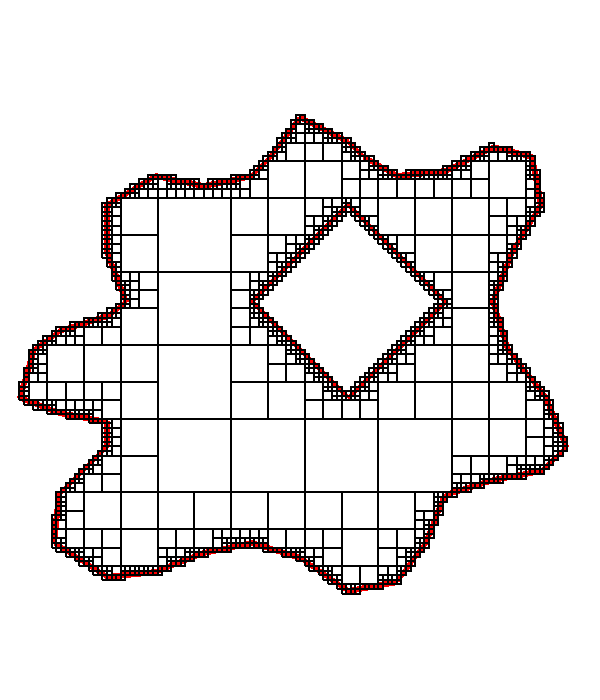
CASE : 2
------
Another Orbitary figuare ( Apple
).

CASE : 3
-----
Another Fiquare consisting a hole
at middle.

CASE : 4
-----
Another Fiquare (plane in top view).

CASE : 5
-----
It is a simple case, but it indicate
an important thing that The four squares which were gotten by subdivision
of universe square are completly inside or out side due that it hasn't
subdivided further and came out eventhough tree level has been given greater
than 1.
It is an Inverted L-Shape
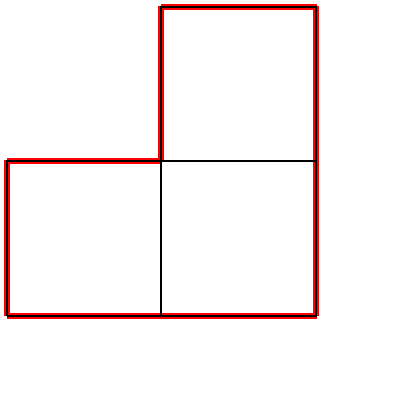
Conclusions and Future work
My work on a generalisation
of the Quad Tree Datastructure has shown that decreased number of elements
as compared with other decompositions.The main advantages over the other
decomposition are reduced memory and computational work, it will be more
compatable for any complex objects and it reduces the analysis time drastically.Any
physical properties are easily estimated approxmately.It provides good
aspect ratio also. Above results indicate that this approch offers increased
versatality for any complex 2D objects.
There are many ways too extend the ideas presented here.
1. This can be extended for 3D objects(Octree).
2. This can be extended for curved
apprxmation rather then polygon approxmation of actual object.
References
1.Sapadis, N,and R.perucchio;
" Advanced techniques for Automatic finite element meshing from models,"computer
aided desisn,Vol.21,no.4,pp-248_253,1989.
2.Bryant,c.f; " Two dimentional
Automatic triangular mesh generation,"IEEE Trans magnetics, Vol.MAG-21,no.6,
pp 2547_2550,1985.
3.Indranil chakravarthy,Ingrid
Carlbom: " A hierarchical data structure for representing the spatia; decomposition
of 3D objects,"IEEE, computer graphics and applicatios",vol.1,No.3,pp:24-31,1985.
/k3/sraos/www/751/proj/bib1
4.Yerry and Mark A Shephard: "
A Modified Quadtree approch to finite element mesh generation","IEEE,Computeri
Graphics and Applications,vol.3,no.1, pp"33-46,1983.
/k3/sraos/www/751/proj/bib2
5.CAD/CAM Theory And Practice
Author: Ibrahim Zeid
publication : Mc Graw-Hill international
editions
Computer science series.
6.CAD theory and applications
Author: Roger and Adams.